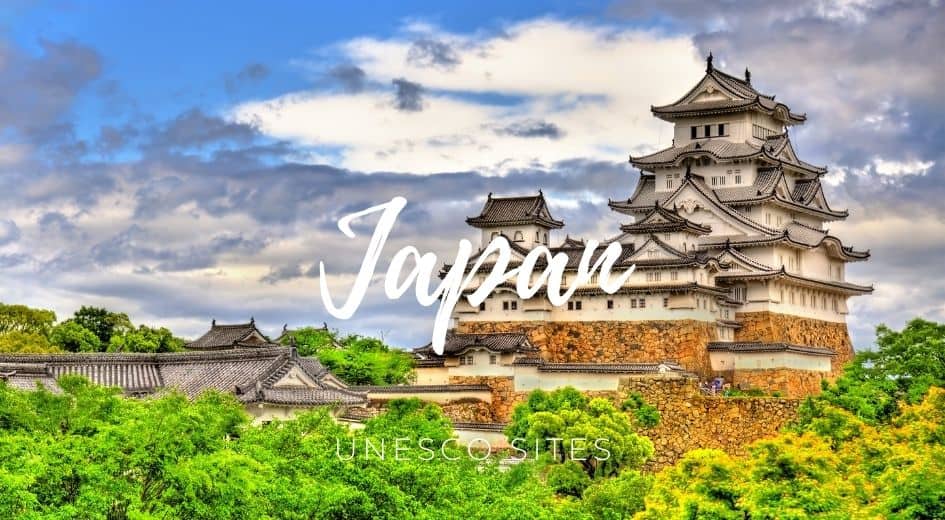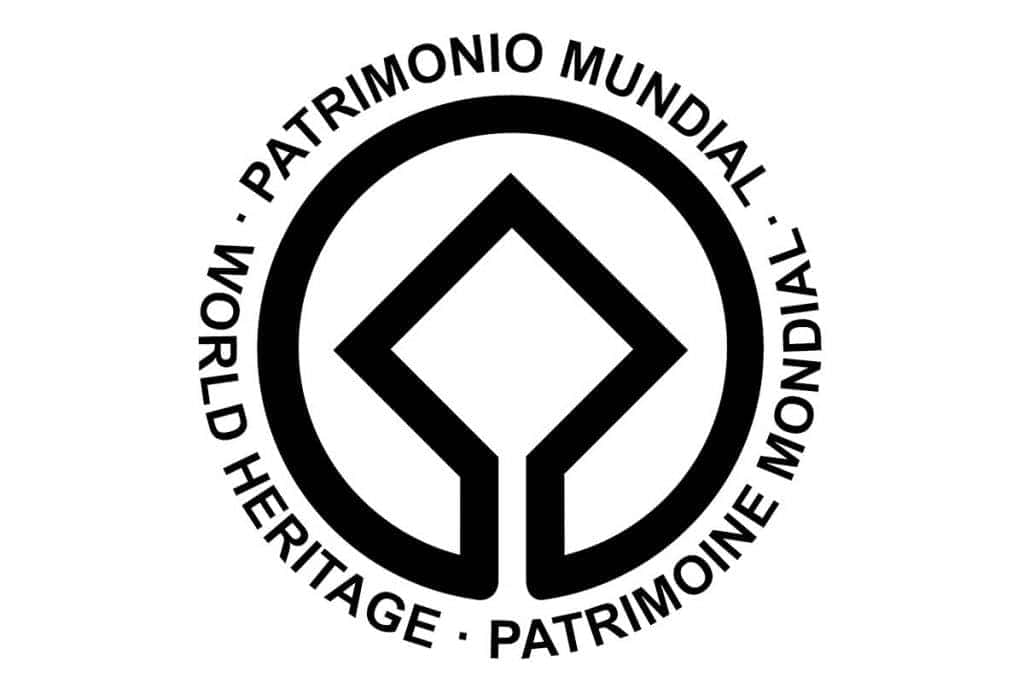Table of Contents


Japan UNESCO has registered 25 sites on the World Heritage list and 5 on the tentative list.
Some places are so interesting that it’s relevant to keep them for future generations. This is why UNESCO has built a list of crucial classified properties in which superb places stand out for their aesthetic, natural, artistic, or cultural significance.
More than a thousand places are registered as Unesco’s World Heritage worldwide. Due to my interest in visiting World Heritage sites, I compiled the UNESCO list in Japan and the corresponding map.
Japan UNESCO list
- Buddhist Monuments in the Horyu-ji Area
- Fujisan, sacred place and source of artistic inspiration
- Gusuku Sites and Related Properties of the Kingdom of Ryukyu
- Hidden Christian Sites in the Nagasaki Region
- Himeji-jo
- Hiraizumi – Temples, Gardens and Archaeological Sites Representing the Buddhist Pure Land
- Hiroshima Peace Memorial (Genbaku Dome)
- Historic Monuments of Ancient Kyoto (Kyoto, Uji and Otsu Cities)
- Historic Monuments of Ancient Nara
- Historic Villages of Shirakawa-go and Gokayama
- Itsukushima Shinto Shrine
- Iwami Ginzan Silver Mine and its Cultural Landscape
- Jomon Prehistoric Sites in Northern Japan
- Mozu-Furuichi Kofun Group: Mounded Tombs of Ancient Japan
- Sacred Island of Okinoshima and Associated Sites in the Munakata Region
- Sacred Sites and Pilgrimage Routes in the Kii Mountain Range
- Shrines and Temples of Nikko
- Sites of Japan’s Meiji Industrial Revolution: Iron and Steel, Shipbuilding and Coal Mining
- The Architectural Work of Le Corbusier, an Outstanding Contribution to the Modern Movement
- Tomioka Silk Mill and Related Sites
- Amami-Oshima Island, Tokunoshima Island, Northern part of Okinawa Island, and Iriomote Island
- Ogasawara Islands
- Shirakami-Sanchi
- Shiretoko
- Yakushima
Japan UNESCO Map
Click on the blue pins to view more relevant information about each World Heritage site in Japan.
Description
- Buddhist Monuments in the Horyu-ji Area is a cultural heritage site in Nara Prefecture, Japan. It contains several important Buddhist temples and artifacts dating back to the Asuka and Nara periods of Japanese history.
- Fujisan, a sacred place and artistic inspiration source, is a natural heritage site in central Japan. It is known for its iconic Mount Fuji, an important symbol of Japanese culture and has inspired many works of art.
- Gusuku Sites and Related Properties of the Kingdom of Ryukyu is a cultural heritage site on Japan’s Ryukyu Islands. It contains several important historical sites related to the Ryukyu Kingdom, which existed from the 15th to the 19th century.
- Hidden Christian Sites in the Nagasaki Region is a cultural heritage site in Nagasaki Prefecture, Japan. It contains several important historical sites related to Christianity in Japan, including hidden churches and other religious artifacts.
- Himeji-jo is a cultural heritage site located in Hyogo Prefecture is a well-preserved castle from the feudal era of Japanese history and is considered a masterpiece of Japanese castle architecture.
- Hiraizumi – Temples, Gardens and Archaeological Sites Representing the Buddhist Pure Land is a cultural heritage site in Iwate Prefecture, Japan. It contains some important historical sites related to the development of Japanese Buddhism, including temples, gardens, and other cultural artifacts.
- Hiroshima Peace Memorial (Genbaku Dome) is a cultural heritage site in Hiroshima, Japan. It symbolizes the devastating effects of atomic warfare and is a reminder of the importance of world peace.
- Historic Monuments of Ancient Kyoto (Kyoto, Uji, and Otsu Cities) is a cultural heritage site in Kyoto Prefecture, Japan. It contains a number of important historical sites related to the development of Japanese culture, including Buddhist temples, Shinto shrines, and other cultural artifacts.
- Historic Monuments of Ancient Nara is a cultural heritage site in Nara Prefecture, Japan. It contains a number of important historical sites related to the development of Japanese culture, including Buddhist temples, Shinto shrines, and other cultural artifacts.
- Historic Villages of Shirakawa-go and Gokayama is a cultural heritage site located in the mountains of central Japan. It contains a number of well-preserved traditional Japanese villages and houses, which are examples of unique regional architecture.
- Itsukushima Shinto Shrine is a cultural heritage site on Miyajima Island in Hiroshima Prefecture, Japan. It is known for its iconic “floating” torii gate and is considered one of the most scenic spots in Japan.
- Iwami Ginzan Silver Mine and its Cultural Landscape is a cultural heritage site in Shimane Prefecture, Japan. It contains a number of important historical sites related to the mining and processing of silver during the Edo period of Japanese history.
- Jomon Prehistoric Sites in Northern Japan is a cultural heritage site in northern Japan. It contains many important archaeological sites related to the Jomon period of Japanese history, including settlements, pottery, and other cultural artifacts.
- Mozu-Furuichi Kofun Group: Mounded Tombs of Ancient Japan is a cultural heritage site in Osaka Prefecture, Japan. It contains several important burial mounds from the Kofun period of Japanese history, from the 3rd to the 7th century.
- Sacred Island of Okinoshima and Associated Sites in the Munakata Region is a cultural heritage site located on Okinoshima Island and in the Munakata region of Fukuoka Prefecture.
- Sacred Sites and Pilgrimage Routes in the Kii Mountain Range is a cultural heritage site located in the Kii Mountains of Japan. It contains some important religious sites related to Shintoism and Buddhism and pilgrimage routes used for centuries.
- Shrines and Temples of Nikko is a cultural heritage site in Tochigi Prefecture, Japan. It contains important Shinto shrines, Buddhist temples, and other cultural artifacts.
- Sites of Japan’s Meiji Industrial Revolution: Iron and Steel, Shipbuilding, and Coal Mining is a cultural heritage site throughout Japan. It contains many important sites related to the modernization of Japan during the Meiji era, including iron and steel mills, shipyards, and coal mines.
- The Architectural Work of Le Corbusier, an Outstanding Contribution to the Modern Movement, is a cultural heritage site in Tokyo, Japan. It is a collection of buildings designed by the famous Swiss-French architect Le Corbusier, considered one of the most important architects of the 20th century.
- Tomioka Silk Mill and Related Sites is a cultural heritage site in Gunma Prefecture, Japan. It contains several important sites related to silk production during the Meiji era, including a well-preserved silk mill and other cultural artifacts.
- Amami-Oshima Island, Tokunoshima Island, the Northern part of Okinawa Island, and Iriomote Island are natural heritage sites in southern Japan. They are known for their unique ecosystems and rich biodiversity.
- Ogasawara Islands is a natural heritage site in the Pacific Ocean, south of Tokyo, Japan. It is a collection of islands known for their unique ecosystems and geological features.
- Shirakami-Sanchi is a natural heritage site located in northern Japan. It is a well-preserved example of a beech forest ecosystem and contains a number of important natural landmarks.
- Shiretoko is a natural heritage site located in Hokkaido, Japan. It is a well-preserved example of a northern cold-water ecosystem and contains a number of important natural landmarks.
- Yakushima is a natural heritage site located in Kagoshima Prefecture, Japan. It is known for its unique ecosystem, rich biodiversity, and ancient cedar forests.
UNESCO World Heritage Sites in Japan have protected places for their cultural and natural importance.
Sites on the Tentative List
- Temples, Shrines, and other structures of Ancient Kamakura
- Hikone-Jo (castle)
- Asuka-Fujiwara: Archaeological Sites of Japan’s Ancient Capitals and Related Properties
- The Sado complex of heritage mines, primarily gold mines
- Hiraizumi – Temples, Gardens, and Archaeological Sites Representing the Buddhist Pure Land (extension)


